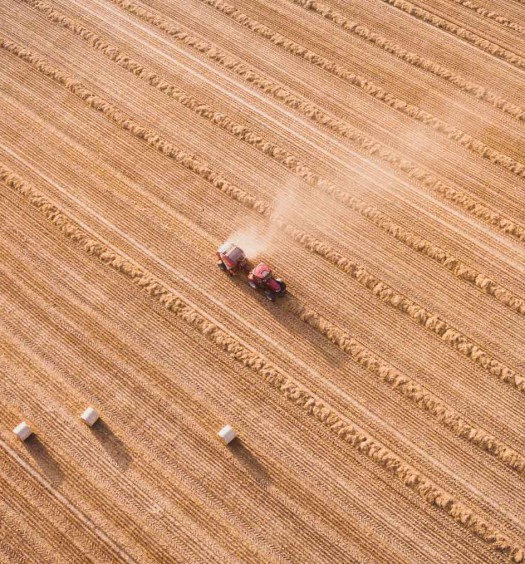It is still too early to draw conclusions about 2024, but the main trends are already evident: in the markets, breakfast undeniably reigns supreme, with the recent coffee frenzy (reminiscent of the historic freeze of 1976 and the epic rise of the Bogota cartel), the rebound of cocoa once again, orange juice, and the resilience of sugar.
For such a feast, a touch of gold is also required, which was in the spotlight, fueled by the drumbeats of conflict that, from Ukraine to the Middle East and Sudan to the Sahel, sadly defined the year. Geopolitical tensions also impacted natural gas prices in Europe, container freight rates, tin, and, more anecdotally, antimony, used in munitions. The cycle comes full circle! Finally, all of this can be paid for in a dollar that continued to appreciate—or better yet, in bitcoin, which surpassed the $100,000 mark in early December. Perhaps it was even in bitcoin that a young cryptocurrency entrepreneur purchased Maurizio Cattelan’s now-famous “banana” for some $6 million.
But 2024 was above all a year of geopolitical tensions of a magnitude unseen in this century. The death toll speaks volumes, whether in Ukraine, around Israel, and now also in Syria, Sudan, and the Sahel. In recent weeks, world leaders have repeatedly gathered in Rio (G20), Lima (APEC), Kazan (BRICS), Baku (COP29), Riyadh (COP on Desertification), and Geneva (WTO), but all to little effect, given the deficiencies of global governance and increasingly pronounced divides. Indeed, national political situations hardly lend themselves to progress, at least in democracies (dictatorships—which are becoming more numerous—have the “advantage” of a certain “stability”). In Europe, beyond the chaos in France and uncertainties in Germany, the rise of populism weakens and divides. In Asia, Japan and South Korea are struggling, and Latin American democracies are faring no better. Meanwhile, the United States has once again brought Donald Trump to power, giving him control of Congress as well. This portends an intensification of existing protectionist trends, tariff wars, embargoes, and boycotts: for instance, China has just imposed an embargo on gallium, germanium, and antimony exports to the U.S., while Algeria has decided to boycott French wheat. And with his enthusiasm for “Tariffs,” Donald Trump has ramped up duties by 25% to as much as 100%!
He does have some luck, however, inheriting on January 20 an American economy growing at around 2–2.5%, thanks to the effectiveness of “Bidenomics.” Of course, it remains to be seen what influence the “Doge of Mar-a-Lago” (Elon Musk) will have, but nothing seems impossible for the man who lands rockets! Across the Atlantic, however, doubt prevails, with a sick man (Germany), a political cripple (France), and at least a bit of sunshine in the Mediterranean. But between the U.S. and the EU, the growth differential (at least 1%) will persist into 2025. American euphoria, European gloom—the real question, which holds major influence over commodity markets, is China. Chinese growth continues to disappoint, closer to 4% than the 5% announced by the Party. The latest stimulus plan ($1.4 trillion for local governments, but mainly to clear their debts) has underwhelmed: China is aging, and its investment-driven industrial model is running out of external outlets, while weak domestic consumption generates surpluses and overcapacity. China remains, for now, the world’s largest consumer of almost all commodities, but in many cases, like oil, we are nearing “Peak China.” The parallel with Japan in the 1990s is still premature but increasingly relevant.
Thus, 2024 ends with far more questions than certainties. The year’s auction record in New York was $121 million (we’ve seen higher!) for a Magritte painting, The Empire of Light. But indeed, it is darkness we are discussing today.
This is an excerpt from the monthly summary published by Cercle CyclOpe. The full version, spanning 150 pages, is available by subscription. For more information, please contact us at cyclope@ampersandworld.ch
Market brief, November 2024
Energy
❚ In October, China imported only 10.53 mbpd of oil, 1 mbpd less than a year earlier and 500,000 bpd less than in September. Over the first ten months of the year, oil refining fell by 2% to 14.14 mbpd. Meanwhile, domestic production rose by 2% to 4.25 mbpd.
❚ The U.S. EIA revised its oil production estimates to 12.23 mbpd in 2024 (+300,000 bpd) and 13.53 mbpd in 2025. For global production, estimates are 102.6 mbpd in 2024 and 104.5 mbpd in 2025. Regarding demand, the EIA forecasts 1 mbpd growth in 2024, aligning more closely with the IEA’s prediction (920,000 bpd) than OPEC’s (1.82 mbpd). The IEA anticipates a global oil surplus of around 1 mbpd in 2025, with demand growing by 990,000 bpd and non-OPEC+ supply increasing by 1.5 mbpd. Notably, the IEA expects Chinese demand to rise by only 140,000 bpd in 2024.
❚ OPEC+ now holds just 48% of global oil production, down from 55% in 2016 when the group formed. OPEC’s share alone has dropped to 25%, with Saudi Arabia accounting for 9%. According to Rystad, the cost of production in the Middle East averages $27 per barrel compared to $45 in North America. In November, OPEC produced 26.5 mbpd, up 180,000 bpd from October, mainly due to increased Libyan production.
❚ The spread between U.S. natural gas prices (Henry Hub) and European prices (TTF) widened by 30% in 2024, rising from $8 per MMBtu to $11 for early 2025 contracts. At this level, the TTF basis is $2 higher than standard LNG contracts indexed to Brent prices. However, in the spot market, prices are closer to $14.50 (e.g., in Egypt).
❚ U.S. oil and gas sectors are celebrating Trump administration nominations influenced by oil magnate Harold Hamm (Continental Resources): Doug Burgum as Interior Secretary and “energy czar,” Chris Wright (Liberty Energy) as Energy Secretary, and climate skeptic Lee Zeldain as head of the EPA. Anticipated actions include approval of the Keystone pipeline, new LNG export projects, and expanded drilling permits on federal and offshore lands.
❚ In Europe, fears over the end of the last Russian gas contracts have pushed prices near €50/MWh ($15 per MMBtu), a 40% increase from September to November. In November, Europe imported 9.16 Mt of LNG, including 4.32 Mt from the U.S.
❚ The dispute between Gazprom and Austria’s OMV threatens a natural gas supply relationship of over 50 years. Despite the conflict, Gazprom continues to sell gas to Slovakia’s SPP, which resells some to OMV.
❚ U.S. oil imports from Canada and Mexico are unlikely to escape Trump’s proposed 25% tariffs. In 2024, the U.S. imported 4 mbpd from Canada and 1.2 mbpd from Mexico, essential for balancing U.S. refinery operations.
❚ Most analysts agree that China’s “peak oil” is near or already passed, particularly for fuels like gasoline and diesel. Consultant FGE predicts a peak at 11.2 mbpd in 2025, while S&P Commodities suggests 2027. Including liquids used in petrochemicals (naphtha, LPG, ethane), the IEA projects 2030, with total demand at 18.1 mbpd.
❚ One reason for tight European gas markets is reduced wind power generation in Germany (-25% in October and November) due to calm weather, leading to a 79% increase in gas usage in November.
❚ OPEC+ postponed any quota increases until April. The 2.2 mbpd in question would now be released over 18 months. The UAE also agreed to forego its planned 300,000 bpd increase.
Minerals and Metals
❚ Codelco is expected to produce 1.3 Mt of copper in 2024, a modest 0.5% increase from 2023, marking the end of nearly 25 years of declining production. However, the company remains in crisis.
❚ Deep-sea mining in Norway faces opposition from an environmental party conditioning government support on halting initial tenders.
❚ Concerns are growing over safety in Chinese-controlled Indonesian nickel plants, particularly at Tsinshan’s Morowali industrial park in Sulawesi, following several fatal accidents.
❚ Wogen Resources signed a contract to market antimony production from Australia’s Hillgrove mine, which will produce 5,400 tonnes annually (7% of global output).
❚ China imposed an export ban on gallium, germanium, and antimony to the U.S.
❚ In the first nine months of 2024, the zinc market saw a slight deficit of 7,000 tonnes (compared to a 372,000-ton surplus in 2023). Lead experienced a deficit of 15,000 tonnes, while copper had a 359,000-ton surplus.
❚ By 2030, Latin America is expected to remain the leading copper producer. According to the USGS, Chile leads in reserves (190 Mt), followed by Peru (120 Mt), Mexico (53 Mt), the DRC (80 Mt), and Zambia (21 Mt).
❚ The cobalt market remains depressed at just over $24,000 per tonne, returning to early-2000s levels. The rise of LFP batteries (cobalt-free) has reduced demand growth, while supply has increased due to CMOC and Glencore.
❚ Despite a slight recovery in October, China’s steel production over the first ten months reached 850 Mt, down 3% from 2023.
Grains and Agriculture
❚ Russian grain statistics indicate that 5 Mt (including 4 Mt of wheat) originate from Russian-controlled Ukrainian regions.
❚ India’s rice stocks reached a record 29.7 Mt thanks to export restrictions over the past two years. This year, India’s Food Corporation is expected to buy 48.5 Mt of summer rice, raising storage concerns.
❚ Amid pending U.S.-China tariff conflicts, China has dramatically increased American soybean purchases: 541,000 tonnes in October 2024, compared to 228,000 tonnes in October 2023. However, January-October imports totaled only 5.33 Mt from the U.S., versus 67.8 Mt from Brazil.
❚ The International Grains Council projects 2024/25 global wheat production at 796 Mt, down slightly due to a sharp drop in European output (120 Mt vs. 133 Mt). Corn production is expected to reach 1,225 Mt, and soybeans 419 Mt, up from 396 Mt in the previous year.
❚ Thailand, the second-largest rice exporter, shipped 8.37 Mt in the first ten months of 2024 (+20%). To boost production, a $1.1 billion subsidy will be provided to farmers.
❚ Concerns over cocoa supply have driven prices above $9,000 per tonne in New York (+45% since October 20 lows). Weak weather conditions in West Africa and three years of global deficits have pushed prices to record highs.

Le Cercle CyclOpe
Its purpose is to regularly bring together (twelve times a year) stakeholders in international markets: bankers, insurers, brokers, managers, traders, producers, and consumers gather informally over lunch to exchange ideas.
Full membership in Cercle CyclOpe includes:
• Cercle meetings:
Six lunches are held in Paris, at L’Automobile Club de France.
Six lunches are held in Geneva, at Cercle de La Terrasse.
• The annual CyclOpe report (Available in both print and digital formats, in English and French);
• Access to the Cercle des Experts and the international CyclOpe network;
• Subscription to the monthly summary (Each month, a comprehensive document exceeding 150 pages, serving as a reference).
To subscribe to CyclOpe reports or events, please contact us at cyclope@ampersandworld.ch.
Find out more about Cercle Cyclope

















Social Community